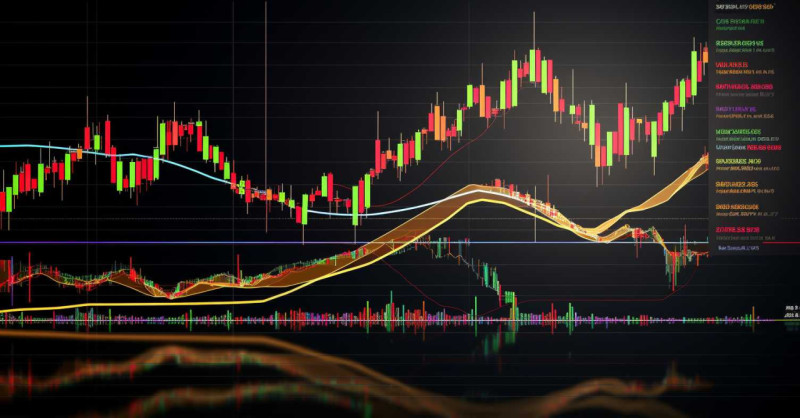
Introduction
Definition of "Awesome Oscillator"
The Awesome Oscillator, often abbreviated as AO, is a technical analysis tool used to measure market momentum. It was developed by Bill Williams, a well-known trader and author. The Awesome Oscillator is calculated by subtracting a 34-period Simple Moving Average (SMA) from a 5-period SMA. These SMAs are based on the midpoint of the price bar ((high + low)/2), rather than closing prices, which are more commonly used.
Presented as a histogram, the Awesome Oscillator offers a visual representation of the 'awesome' power of market momentum. When the oscillator is above the zero line, it indicates bullish market momentum, and when it's below the zero line, it signifies bearish momentum. Its purpose is to generate buy and sell signals based on zero-line crossovers, 'saucer' formations, and 'twin peaks' patterns, which we will discuss later in the article.
Brief background and history of Awesome Oscillator
The Awesome Oscillator is a product of the innovative mind of Bill Williams, a prominent figure in the world of trading and technical analysis. He conceptualized and developed the Awesome Oscillator during the 1980s, incorporating it as a key component of his trading system.
Bill Williams' work is influenced by his belief in the applicability of Chaos Theory in financial markets. He wanted to create a system that can effectively identify and interpret the 'chaos' or unpredictability of market movements. His aim was to establish a clear method for recognizing the start of new trends and potential reversals.
The Awesome Oscillator is an embodiment of Williams' philosophies. It is designed to compare market momentum over two distinct periods, usually five and 34 periods. The purpose of this comparison is to evaluate the 'force' or momentum behind market moves. This allows traders to get a sense of whether bulls or bears are in control, and predict possible reversals or continuation of trends.
Since its inception, the Awesome Oscillator has become a staple in the toolbox of many technical traders due to its versatility and effectiveness in various market conditions.
Significance of the Awesome Oscillator in technical analysis
In the realm of technical analysis, the Awesome Oscillator holds a prominent position due to its multifaceted capabilities. It has been effectively used by traders across the globe for its primary purpose – to identify potential changes in market momentum that could presage a shift in trend. By doing so, it offers critical insights that help traders anticipate possible market movements, aiding them in making informed trading decisions.
- Detection of Bullish and Bearish Momentum: The AO, with its histogram plotted around a zero line, provides a clear visual representation of the market's momentum. When the AO moves above the zero line, it signals bullish momentum, indicating that it may be a good time to buy. Conversely, when it drops below the zero line, it indicates bearish momentum, which may be a signal to sell.
- Identification of Market Trends and Reversals: The AO can also be used to identify 'saucer' formations and 'twin peaks', which are special patterns that could indicate a potential reversal or continuation of a trend. This early identification can give traders a head start in adjusting their strategies accordingly.
- Confirmation of Trading Signals: The AO can serve as a confirmation tool when used in conjunction with other technical analysis indicators. For instance, a buy signal from another indicator, such as a moving average crossover, could be confirmed if the AO is above zero and increasing, which signifies bullish momentum.
- Versatility: The AO can be applied in various market conditions and across different timeframes, making it a versatile tool in the hands of traders.
In summary, the Awesome Oscillator's significance in technical analysis lies in its ability to effectively measure market momentum, anticipate potential changes in market trends, confirm trading signals, and provide traders with crucial information to guide their trading decisions.

How the Awesome Oscillator Works
Explanation of the calculations behind the Awesome Oscillator
The Awesome Oscillator (AO) is calculated using a relatively simple mathematical formula, but its value lies in the insights this calculation can provide about market momentum. The AO is generated by subtracting a 34-period Simple Moving Average (SMA) from a 5-period SMA, both of which are calculated on the midpoint of the price bar, rather than the closing prices.
The midpoint of the price bar is calculated by taking the average of the high and the low price for the period. So, the formula for the midpoint is:
Midpoint = (High + Low) / 2
The 5-period SMA and 34-period SMA are then calculated on these midpoints.
Next, we calculate the Awesome Oscillator by subtracting the 34-period SMA from the 5-period SMA:
Awesome Oscillator = 5-period SMA - 34-period SMA
The resulting value gives a measure of the market momentum. Positive values indicate bullish (upward) momentum, while negative values indicate bearish (downward) momentum. The greater the absolute value of the AO, the stronger the perceived momentum.
It's important to remember that because the Awesome Oscillator is based on historical price data, it is considered a lagging indicator. This means it tends to confirm trends and momentum shifts, rather than predicting them.
Description of how the Awesome Oscillator presents on a trading chart
The Awesome Oscillator (AO) is typically displayed in a separate window or panel below the main price chart in most trading platforms. It is presented as a histogram, which is a series of vertical bars.
Each bar of the histogram corresponds to the value of the Awesome Oscillator for that specific period. This value is calculated by subtracting the 34-period Simple Moving Average (SMA) from the 5-period SMA. The zero line in the middle of the histogram serves as a reference point, indicating when the 5-period SMA is above or below the 34-period SMA.
When the 5-period SMA is higher than the 34-period SMA, the Awesome Oscillator value is positive and the histogram bar is drawn above the zero line. Conversely, when the 5-period SMA is lower than the 34-period SMA, the AO value is negative and the histogram bar is plotted below the zero line.
The height of the bars represents the strength of the momentum. Tall bars, either above or below the zero line, signify strong momentum, while short bars suggest weak momentum.
The ability to visualize these changes in market momentum over time makes the Awesome Oscillator a valuable tool in the arsenal of many traders.
Discussion of the meaning behind the Awesome Oscillator's color-coded histogram
The Awesome Oscillator histogram uses a color-coding system, typically green and red, to indicate changes in market momentum. Here's what the colors mean:
- Green Bars: A green bar appears when the value of the current bar is greater than the value of the previous bar. This suggests an increase in momentum. If the green bar is above the zero line, it signifies that bullish momentum is increasing. If it's below the zero line, it indicates that bearish momentum is decreasing.
- Red Bars: A red bar appears when the value of the current bar is less than the value of the previous bar. This suggests a decrease in momentum. If the red bar is below the zero line, it implies that bearish momentum is increasing. If it's above the zero line, it signifies that bullish momentum is decreasing.
The color of the bars is important as it provides traders with an additional layer of information about market momentum. Green bars suggest that the bulls (buyers) are gaining control, whereas red bars suggest that the bears (sellers) are gaining control.
However, it's important to remember that the color of the bars doesn't necessarily indicate a buy or sell signal on its own. Instead, they should be used in conjunction with other aspects of the Awesome Oscillator and other technical analysis tools to make informed trading decisions.

The Basics of Using the Awesome Oscillator
Explanation of bullish and bearish market trends as indicated by the Awesome Oscillator
In the world of trading, market trends are classified as either bullish or bearish. The Awesome Oscillator (AO) is a popular tool among traders to identify these trends, and here's how it does that:
- Bullish Trends: A bullish market trend, also known as an uptrend, is characterized by rising prices. When using the AO, a bullish trend is signaled when the value of the oscillator is above the zero line. In this situation, the 5-period simple moving average (SMA) of the midpoint of the price bar is greater than the 34-period SMA. This means that the short-term momentum is stronger than the long-term momentum, suggesting that the bulls (buyers) are in control and the prices are likely to continue rising.
- Bearish Trends: A bearish market trend, or a downtrend, is characterized by falling prices. In the context of the AO, a bearish trend is signaled when the value of the oscillator is below the zero line. This indicates that the short-term momentum (5-period SMA) is weaker than the long-term momentum (34-period SMA), suggesting that the bears (sellers) are in control and prices are likely to continue falling.
It's worth mentioning that while the AO is a powerful tool to identify market trends, it should not be used in isolation. Other market indicators and economic factors should also be considered to make more informed trading decisions.
Demonstration of the zero-line crossover and how it informs trading decisions
The zero-line crossover is a crucial aspect of the Awesome Oscillator (AO) and plays a significant role in informing trading decisions. The AO is represented as a histogram oscillating above and below a zero line, and the points where the histogram crosses this line are known as zero-line crossovers. These crossovers indicate shifts in market momentum and can provide potential trading signals.
- Bullish zero-line crossover: This occurs when the AO moves from below the zero line to above it. This signals a shift in momentum from bearish to bullish, indicating that the short-term momentum is now exceeding the long-term momentum. Traders often interpret this as a potential buying opportunity, as it can suggest the start of an upward trend or a bullish swing within a broader trend.
- Bearish zero-line crossover: This occurs when the AO moves from above the zero line to below it. This suggests a shift in momentum from bullish to bearish, indicating that the long-term momentum is now stronger than the short-term momentum. Traders often see this as a potential selling opportunity, as it can signal the beginning of a downward trend or a bearish swing within a larger trend.
It's important to note that while zero-line crossovers can provide useful signals, they should not be used as the sole basis for trading decisions. The AO, like any other technical indicator, can produce false signals, and the accuracy of its signals can be influenced by market volatility and other factors. Therefore, zero-line crossovers are often used in conjunction with other technical analysis tools and in the context of a broader trading strategy. Always consider other market information and indicators to confirm signals and make more informed trading decisions.
Discussion of "saucer" signals and what they mean
"Saucer" signals are another key aspect of the Awesome Oscillator (AO) that traders use to make informed decisions. These signals are so-named because the pattern formed on the histogram resembles the shape of a saucer or shallow bowl.
- Bullish Saucer: A bullish saucer signal occurs when the AO is above the zero line and three consecutive bars form a specific pattern: the first two bars are red (with the second bar being shorter than the first), and the third bar is green. This pattern indicates a brief slowdown in bullish momentum followed by a resurgence, suggesting that the overall bullish trend is likely to continue. Therefore, a bullish saucer is often interpreted as a potential buying opportunity.
- Bearish Saucer: A bearish saucer signal occurs when the AO is below the zero line and three consecutive bars form the following pattern: the first two bars are green (with the second bar being shorter than the first), and the third bar is red. This pattern suggests a short pause in bearish momentum followed by a return to downward movement, implying that the overall bearish trend is likely to persist. Consequently, a bearish saucer is typically seen as a potential selling opportunity.
However, while saucer signals can provide valuable trading insights, they should be used in conjunction with other technical indicators and market analysis tools. Saucers are relatively rare events compared to zero-line crossovers, and, like any trading signal, they can occasionally produce false indications. Always consider the broader market context when interpreting saucer signals, and validate them with additional analysis to improve the accuracy of your trading decisions.

Advanced Techniques and Strategies with the Awesome Oscillator
Detailed Explanation of the "Twin Peaks" Method
The "Twin Peaks" method is a strategy used with the Awesome Oscillator to identify potential reversals in market trends. This pattern consists of two peaks on the AO histogram.
Bullish Twin Peaks: This is a buy signal that occurs when the AO forms two peaks below the zero line, with the second peak higher than the first, followed by a green bar. The idea is that although the momentum remains negative (as indicated by the AO being below the zero line), it's less negative with the second peak, suggesting a potential upward reversal in the price trend.
Bearish Twin Peaks: This is a sell signal that happens when the AO forms two peaks above the zero line, with the second peak lower than the first, followed by a red bar. Despite the momentum being positive (as indicated by the AO being above the zero line), it's less positive with the second peak, suggesting a potential downward reversal in the price trend.
Demonstration of "Zero Line Crossover" Technique
The Zero Line Crossover technique has been previously discussed in section III.B. For advanced traders, this technique can be combined with other indicators or used to confirm signals from other technical analysis methods. For instance, a bullish zero-line crossover might be used in conjunction with a positive signal from a moving average crossover strategy or a breakout above a resistance level.
Discussion on How to Interpret and Apply "Bullish or Bearish Divergence"
Divergence is a situation where the price chart and a technical indicator, in this case, the AO, are moving in opposite directions. It's considered a strong signal that a current trend might be weakening and could reverse soon.
Bullish Divergence: This occurs when the price is making lower lows, but the AO is making higher lows. This suggests that while the price trend is downward, the momentum is losing strength, and a bullish reversal might occur. Traders might consider this as a potential buying opportunity.
Bearish Divergence: This happens when the price is making higher highs, but the AO is making lower highs. This indicates that the upward price trend is losing momentum, and a bearish reversal might be imminent. Traders might consider this as a potential selling opportunity.
Divergence should be confirmed with a corresponding change in price action (for example, a break of trendline or resistance/support level) before making a trading decision. And like other signals, it's best used in conjunction with other technical analysis tools.

Practical Application: Incorporating the Awesome Oscillator into Your Trading Strategy
Tips for Effectively Integrating the Awesome Oscillator into Existing Trading Strategies
Combine With Other Indicators: The Awesome Oscillator (AO) can provide valuable insights, but it's more effective when used in combination with other technical analysis tools. Consider integrating it with moving averages, trend lines, support and resistance levels, or other momentum indicators to confirm signals and increase the accuracy of your trading decisions.
Apply Multiple Time Frames: Utilize the AO in different time frames to gain a broader market perspective. For example, while the daily chart may show a bullish trend, the hourly chart may be bearish. This can help you identify the best entry and exit points for your trades.
Be Patient and Disciplined: Wait for confirmation from the AO before executing trades. Patience and discipline can help avoid false signals and premature trades.
Case Studies Demonstrating the Successful Use of the Awesome Oscillator
Case Study 1: Trading a Bullish Twin Peaks Setup
For this example, let's use a hypothetical situation based on historical data from a highly traded asset like the EUR/USD currency pair.
In the first quarter of 2023, EUR/USD showed a downward trend. However, in early March, the Awesome Oscillator formed two peaks below the zero line, with the second peak higher than the first, followed by a green bar. This pattern represented a bullish Twin Peaks setup. A trader who identified this pattern could have seen it as a signal that the previous downtrend might be losing strength.
With further analysis, the trader might have noticed a bullish divergence as well: while the price continued making lower lows, the AO was making higher lows. This added confirmation would make the Twin Peaks setup a strong buy signal. If the trader decided to enter a long position based on this signal, they could have profited from the subsequent uptrend that unfolded over the next few weeks.
Case Study 2: Integrating the AO with a Moving Average Strategy
Let's consider another hypothetical example using the AO in conjunction with another indicator - the 50-day Simple Moving Average (SMA).
Let's take the Apple stock (AAPL) during the third quarter of 2023. AAPL was trading above the 50-day SMA, suggesting a bullish trend. However, an experienced trader would know not to rely on a single indicator and would look for confirmation from another source.
Here, the AO could serve as that source. In this period, the AO was mostly above the zero line, aligning with the bullish indication from the SMA. When the AO crossed below the zero line, it could be a sign of a temporary slowdown or potential reversal.
By combining these two indicators, a trader could have used the 50-day SMA to identify the overall trend and the AO to time their entries and exits. When the AO and SMA gave contradictory signals, the trader might choose to hold off on making new trades until the signals realigned.
These case studies demonstrate the AO's potential when used as part of a comprehensive trading strategy. As always, remember that no strategy guarantees success, and all trading strategies carry the risk of losses. Traders should always perform their analysis and consider their risk tolerance.

Advice on Mitigating Risk and Protecting Investments When Using the Awesome Oscillator
Use Stop Loss Orders: A stop loss order is a key risk management tool that can automatically close your trade if the market moves against your position by a certain amount. Set your stop loss at a level that represents an acceptable loss for you.
Consider Your Risk to Reward Ratio: This ratio measures the potential profit of a trade compared to the potential loss. A good rule of thumb is to aim for trades with a risk to reward ratio of at least 1:2. This means the potential profit should be twice the amount of the potential loss.
Continual Learning and Evaluation: Always review your trades and evaluate your success and mistakes. Use this information to refine your strategies and improve your trading performance over time.
Diversify: Diversifying your investment portfolio can help manage risk. It's recommended not to rely solely on one technical indicator or trading strategy.
Always Stay Informed: Stay updated with financial news and global events as they can significantly influence market trends. Economic calendars can be a great tool for this.
Comparison: Awesome Oscillator vs. Other Trading Indicators
Comparison of the Awesome Oscillator with other popular technical analysis tools like MACD, RSI, etc.
Awesome Oscillator vs. MACD (Moving Average Convergence Divergence):
The MACD is another momentum oscillator often used to identify potential buy and sell signals. Similar to the Awesome Oscillator, MACD also uses a histogram to visualize the difference between two moving averages - specifically, it subtracts the 26-period Exponential Moving Average (EMA) from the 12-period EMA. An additional 9-period EMA of the MACD, known as the "signal line," is also plotted to trigger trading signals.
Both the AO and MACD are used to recognize trend strength and direction, but they use different calculations and approaches. While AO uses the median price and simple moving averages, MACD employs closing prices and exponential moving averages. Therefore, MACD may respond faster to recent price changes, whereas the AO could offer a broader perspective of market momentum.
Awesome Oscillator vs. RSI (Relative Strength Index):
The RSI is a popular momentum oscillator used to identify overbought or oversold conditions. Unlike the Awesome Oscillator, which oscillates around a zero line and provides insights about momentum and potential reversals, the RSI oscillates between 0 and 100, giving traders insights about possible price reversals due to overbought (RSI above 70) or oversold conditions (RSI below 30).
Awesome Oscillator vs. Stochastic Oscillator:
The Stochastic Oscillator is another popular momentum indicator used to show the location of the close relative to the high-low range over a set number of periods. Like RSI, it ranges between 0 and 100 and can identify overbought and oversold levels. However, unlike the Awesome Oscillator, which focuses more on the market momentum and the strength of the buyers or sellers, the Stochastic Oscillator primarily provides potential reversal signals based on overbought or oversold conditions.
In conclusion, while each of these indicators has its strengths, they all serve different purposes and provide unique insights. The Awesome Oscillator's simplicity and versatility make it a powerful tool for analyzing market momentum and potential trend reversals. However, for a more comprehensive analysis, it's beneficial to use the Awesome Oscillator in combination with other indicators.

Discussion on when to use Awesome Oscillator and when to use other indicators
The choice between the Awesome Oscillator (AO) and other indicators often depends on the individual trading strategy, the asset being traded, and the specific market conditions.
When to Use the Awesome Oscillator: The AO is particularly effective in identifying changes in market momentum, making it useful for anticipating potential trend reversals. It is also valuable in confirming existing trends, whether bullish or bearish, using signals such as zero-line crossovers and twin peaks patterns.
If your trading strategy is based on trend following or swing trading, the AO could be an excellent tool to integrate into your analysis. The AO might also be the preferred choice when trading assets that display clear trend behaviors, as the AO's strength lies in its ability to analyze momentum over time.
When to Use Other Indicators: Other technical analysis indicators might be more appropriate in certain scenarios. For instance:
a. RSI (Relative Strength Index): The RSI is ideally suited for identifying overbought or oversold conditions, which can indicate potential price reversals. This makes the RSI particularly useful in range-bound markets or when you need to identify possible entry and exit points within a larger trend.
b. MACD (Moving Average Convergence Divergence): If you're interested in analyzing short-term momentum and are comfortable with a more complex calculation, the MACD could be an excellent choice. The MACD's use of exponential moving averages means it reacts more quickly to recent price changes, which can be advantageous in fast-moving markets.
c. Stochastic Oscillator: If your trading strategy involves picking tops and bottoms in a ranging market, the Stochastic Oscillator might be more appropriate. It's designed to show when an asset is overbought or oversold within a specific range, potentially predicting price reversals.
In summary, the Awesome Oscillator is a versatile and valuable tool that can enhance your technical analysis. However, it is not a standalone solution. Successful trading often involves using a combination of indicators to confirm signals and improve accuracy. As always, each indicator should be used in conjunction with an overall risk management strategy.
Conclusion
The Awesome Oscillator, as we've discussed, is an innovative and valuable tool in the world of technical analysis. Its versatility and robust functionality make it stand out among a variety of indicators available to traders. It is not only capable of identifying changes in market momentum and potential trend reversals but also of confirming existing trends.
Whether you are navigating bullish or bearish markets, the Awesome Oscillator can provide valuable insights. From understanding the color-coded histogram to applying the 'saucer signals' and 'twin peaks' methods, we've seen how the Awesome Oscillator can be an essential part of a trader's arsenal.

However, as with any trading tool, using the Awesome Oscillator effectively requires practice and understanding. A strong grasp of its functions, combined with the ability to recognize and respond to its signals, will go a long way in enhancing your trading strategy. It's also worth noting that, while powerful, the Awesome Oscillator works best when used in conjunction with other technical analysis tools. This complementary approach helps provide more comprehensive market insights and solidifies decision-making.
We encourage you to integrate the Awesome Oscillator into your trading strategy and start practicing with it. Understand how it works, observe how it reacts to different market conditions, and learn to interpret its signals correctly. Remember, effective trading is not just about having the right tools—it's about understanding how to use them.
In closing, we hope this guide to the Awesome Oscillator has been enlightening and that it serves you well in your future trading endeavours. Keep honing your skills, stay patient, and let the Awesome Oscillator help guide your path to successful trading.
















